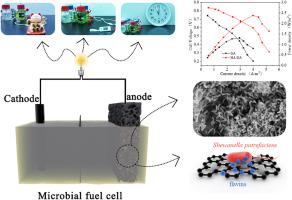Journal of Environmental Chemical Engineering ( IF 7.7 ) Pub Date : 2021-04-09 , DOI: 10.1016/j.jece.2021.105441 Ting Zhao , Zhenghui Qiu , Yu Zhang , Fangming Hu , Jiyong Zheng , Cunguo Lin

|
Bioaffinity of anode materials is a key factor for the power output of microbial fuel cells (MFCs). Anode surfaces with excellent biocompatibility can facilitate bacterial adhesion, biofilm propagation, and extracellular electron transfer. In this study, three-dimensional (3D) hydroxyapatite/graphene aerogel (HA/GA) was synthesized using a facile three-step method: hydrothermal treatment, dialysis, and freeze-drying. The HA/GA anode presented the excellent biocompatibility of HA and high conductivity of graphene. Moreover, the unique edge-to-edge cross-linked architecture of the HA/GA offered a large surface area for bacterial adhesion. Shewanella putrefaciens can generate more flavins through the introduction of highly biocompatible HA nanocrystals on the graphene sheets, leading to a rapid extracellular electron transfer between the biofilm and anode. An MFC containing a HA/GA anode delivered a maximum power density of 2.38 W/m2, which was 1.83 times the power density achieved using a GA anode. Furthermore, MFCs equipped with HA/GA anodes were successfully utilized to drive a series of electrical appliances. The HA/GA anode possessed excellent biocompatibility, large surface area, superior hydrophilicity, and high conductivity, which were conducive for enhancing the surface bioaffinity and accelerating the interfacial charge transfer, thereby improving the electricity generation performance of the MFCs. This study has proven that HA is beneficial for enhancing the interface bioaffinity and that it can be applicable to MFC for high-performance bioelectricity harvesting.
中文翻译:

使用三维羟基磷灰石/石墨烯气凝胶作为微生物燃料电池中的高性能阳极
阳极材料的生物亲和力是微生物燃料电池(MFCs)功率输出的关键因素。具有出色生物相容性的阳极表面可促进细菌粘附,生物膜繁殖和细胞外电子转移。在这项研究中,三维(3D)羟基磷灰石/石墨烯气凝胶(HA / GA)使用简便的三步法合成:水热处理,透析和冷冻干燥。HA / GA阳极具有出色的HA生物相容性和石墨烯的高电导率。此外,HA / GA独特的边对边交联结构为细菌粘附提供了较大的表面积。腐烂希瓦氏菌可以通过在石墨烯片上引入高度生物相容的HA纳米晶体来产生更多的黄素,从而导致生物膜和阳极之间快速的细胞外电子转移。包含HA / GA阳极的MFC的最大功率密度为2.38 W / m 2,这是使用GA阳极实现的功率密度的1.83倍。此外,配备HA / GA阳极的MFC被成功地用于驱动一系列电器。HA / GA阳极具有优异的生物相容性,较大的表面积,优异的亲水性和较高的电导率,有利于增强表面生物亲和力并促进界面电荷转移,从而改善了MFCs的发电性能。这项研究已经证明,HA有助于增强界面生物亲和力,并且可以适用于MFC进行高性能生物电采集。


























 京公网安备 11010802027423号
京公网安备 11010802027423号